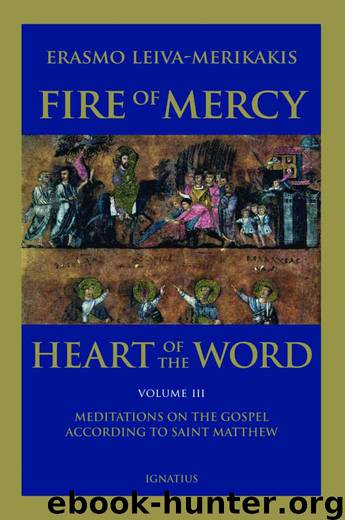Fire of Mercy, Heart of the Word, Vol. 3 by Erasmo Leiva-Merikakis

Author:Erasmo Leiva-Merikakis [Leiva-Merikakis, Erasmo]
Language: eng
Format: mobi
Tags: Religion, Catholicism, Bible Commentary, Christianity
ISBN: 9781586176983
Published: 2013-11-24T05:00:00+00:00
HERE THE TEXT HAS BEEN RENDERED very literally, with the fivefold repetition of and and its intensifying effect. The polysyndeton, with its six action verbs in rapid succession, at once conveys the minute and loving care the owner of the vineyard has lavished on this project, obviously his pride and joy. We get the impression that the whole meaning of the man’s life depended on the fate of this vineyard, on its success or failure.
Our parable is lengthy and quite intricate, and for a good reason: in symbolic language it contains the whole history of human salvation. It first looks backward to the election and formation of Israel by God and to the long line of prophets he sent to his people, culminating in the sending of his own Son at the Incarnation. It portrays graphically the long history of the brutal rejection of the prophets (including Jesus himself, the greatest of prophets, v. 46) by the leaders of Israel. And it then looks forward, from this present moment of Jesus life, to his Passion and death at the hands of his own people, with the final triumph of the Resurrection as God’s ultimate saving deed that brings new life out of death.
Thus, we are not dealing here with an ordinary parable instilling some point of moral or religious instruction. What we have before us is a transparent allegory of the concrete ways in which God has intervened in our history to save us, making us heirs of his Kingdom along with his Son, Jesus.
Our entire Western and Christian conception of history is based on a linear, fourfold scheme. First, God creates the world and chooses Israel as his special people and as bearer of revealed truths. Then, he sends a great number of prophets, beginning with Moses, to call his people back to himself after they have disobeyed him. Finally, he sends his own Son, Jesus, at the Incarnation, and this inaugurates the period of the redemption proper, culminating in Jesus death, Resurrection, and Ascension. The fourth period of salvation history stretches from Jesus Ascension and Pentecost to the Second Coming of Christ at the parousia.
Jesus’ pointed question to his listeners in v. 40 (“When therefore the owner of the vineyard comes, what will he do to those tenants?”) sums up the entire sweep of the narrative and projects it forward to the end-time. The question refers to the great day of “harvest”—the judgment at the end of history when the Lord will return visibly to his vineyard, his world, looking for the ripe fruit he has intended it to bear from the beginning of creation.
A major event in the narrative, and obviously foundational for Christianity, is the “transfer of the Kingdom” from Israel to the Church. Even though at first glance this appears to be nothing but a punishment inflicted on Israel for her refusal to listen to God’s prophets, above all Jesus, nevertheless we must see in this transfer the achievement of God’s desire for the universality of salvation.
Download
This site does not store any files on its server. We only index and link to content provided by other sites. Please contact the content providers to delete copyright contents if any and email us, we'll remove relevant links or contents immediately.
| New Testament | Old Testament |
The Five People You Meet in Heaven by Mitch Albom(2841)
Name Book, The: Over 10,000 Names--Their Meanings, Origins, and Spiritual Significance by Astoria Dorothy(2490)
Real Sex by Lauren F. Winner(2474)
The Holy Spirit by Billy Graham(2414)
The Secret Power of Speaking God's Word by Joyce Meyer(2252)
0041152001443424520 .pdf by Unknown(2219)
How The Mind Works by Steven Pinker(2211)
Ancient Worlds by Michael Scott(2102)
ESV Study Bible by Crossway(2086)
The Meaning of the Library by unknow(2067)
The Gnostic Gospels by Pagels Elaine(2026)
Churchill by Paul Johnson(2009)
MOSES THE EGYPTIAN by Jan Assmann(1970)
The ESV Study Bible by Crossway Bibles(1905)
Jesus by Paul Johnson(1887)
The Nativity by Geza Vermes(1848)
Ancient Near Eastern Thought and the Old Testament by John H. Walton(1845)
The Complete Dead Sea Scrolls in English (7th Edition) (Penguin Classics) by Geza Vermes(1839)
City of Stairs by Robert Jackson Bennett(1825)
